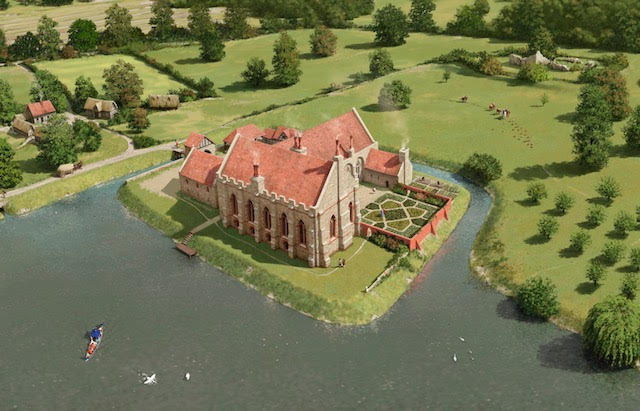Ancient documents charting the life of a castle shrouded in romantic myth and legend are coming home to Coventry
The deeds of Caludon Castle are being loaned to The Herbert museum for public display, lifting a veil on a history spanning more than 800 years.
Alas, for romantics the disclosures will finally put to the sword the popular legend that the castle was the birthplace of St George, England’s heroic patron saint.
That will come a no surprise to historians who’ve long dismissed it as myth, as likely as the existence of fire-breathing dragons which St George reputedly slew in a cave in the centre of Coventry.
But they will be delighted that papers revealing the true story of the castle, whose only remnant stands defiantly in present day Caludon Park, Wyken: a red sandstone wall of the great chambers of lords and ladies.
The Caludon papers, many in vellum or parchment with royal seals including those of King Edward 1, who granted the licence for the castle to be built, and Queen Elizabeth 1, have been stored in the Devonshire home of Lord Clifford, whose ancestors owned the castle and estate during the 18th and 19th centuries.
For Wyken-born John Clarke OBE, the driving force behind the loan of the deeds, it’s another advance in his personal crusade to shine a light on Caludon’s rich tapestry.
The story of the castle has intrigued him since he was a schoolboy kicking a ball about in the shadow of the castle ruins.
Now he hopes that the people of Coventry, given the chance to see for themselves evidence of its colourful history, will be fired by the same enthusiasm he has for this overlooked jewel in the city’s historic crown .
He said: “Over the past five years I have been in discussion with Lord Clifford to bring this about.
“It gives Coventry a fantastic chance to learn more about its colourful history. I am particularly excited as it will allow everyone – whether history buffs or schoolchildren – a unique opportunity to see original medieval records, many in Latin and Old English script.
“Caludon’s past owners included some of the most powerful families in the land, many with strong royal and military links.
“Their influence went far beyond the royal palaces and battlefields. There are Caludon connections to literary giants like Shakespeare and Thomas Malory.”
Mr Clarke, heads Warwickshire-based public relations firm Century, established in Coventry in the mid- 1980s as the city’s first PR company, and is a former deputy chairman of Coventry City FC.
He recently put his passion into print as the creator and publisher of A History of Caludon Castle.
His extensive research for the book took him several times to the country seat of Lord Clifford where the documents had been locked in the Muniments Room for nearly 250 years.
The two men became friends during the visits and Lord Clifford agreed to loosen the reins on the deeds and negotiated an initial five-year loan deal with The Herbert.
Mr Clarke said: “The Clifford family was very impressed by Coventry’s success in winning the bid for the UK City of Culture 2021 and believes the Caludon deeds will be a popular attraction during the celebrations of its cultural heritage.”
The documents will be sent to Coventry by specialist couriers early in the new year.
Extensive work will then be undertaken to catalogue the documents and screen in those suitable for online viewing and selecting those which are in good enough condition to go on public display.
10 things you should know about Caludon Castle1. Caludon Castle actually started life in the 1220s as a wooden manor house surrounded by a moat. The lands around were originally owned by Earl Leofric and Lady Godiva.
2. One of the first Lords of Caludon, Sir John de Segrave, was the King’s Lieutenant in Scotland and was responsible for hunting down and sentencing the Scottish rebel William Wallace (of Braveheart film fame) who he decreed to be ‘hung, drawn and quartered’.
3. Caludon Castle and the manor of Caludon was once owned by the powerful Mowbray family, Dukes of Norfolk and Earl Marshalls of England. Thomas Mowbray, Duke of Norfolk and Lord of Caludon, was famous for the aborted Battle of Gosford Green in Coventry, featured in the first chapter of Richard II by William Shakespeare.
4. Caludon’s royal connections were very strong. Lord Henry Berkeley, Lord of Caludon, was the Godson of King Henry VIII and his son, Lord George Berkeley, the Godson of ‘Queen Bess’, Elizabeth I. Lord Henry, whose family also owned Berkeley Castle, died aged 80 of salmonella after eating a custard tart at Caludon.
5. Shakespeare is believed to have based his famous play, The Taming of the Shrew, on the lives of Lord Henry and Lady Katherine Berkeley, the Lord and Lady of Caludon. The couple were passionate about hunting.
6. Thomas Malory, author of Le Morte D’Arthur, the famous book about the legend of King Arthur was responsible for attacking Caludon Manor in 1451. killing deer and causing over £500 worth of damage, a fortune in medieval times.
7. Although by local legend St George was said to have been born at Caludon, most scholars believe if he existed at all he was born in Cappadocia, Turkey or Lydda in Palestine.
8. The British Library contains a reference to the argument that Shakespeare wrote and first performed his popular play ‘A Midsummer Night’s Dream’ for the marriage of Thomas Berkeley, son of Lord Henry Berkeley, Lord of Caludon, to Elizabeth Carey, daughter of Henry, Lord Hunsdon, the Lord Chamberlain and sponsor of Shakespeare’s troupe ‘The Lord Chamberlain’s players’.
9. For many years historians and local people have been convinced that the castle at Caludon was besieged and destroyed in the English Civil War. However recently discovered records show that the castle existed in its entirety well beyond the Civil War until the 1800s.
10. An iron coffin with the remains of a knight in armour was once unearthed near to the castle and below the farmhouse called Caludon House.
Ancient documents lifting veil on Caludon Castle's romantic legend are coming home to Coventry
1 post
• Page 1 of 1
Ancient documents lifting veil on Caludon Castle's romantic legend are coming home to Coventry
-

dutchman - Site Admin
- Posts: 50482
- Joined: Fri Oct 23, 2009 1:24 am
- Location: Spon End
1 post
• Page 1 of 1
Who is online
Users browsing this forum: No registered users and 2 guests
-
- Ads


